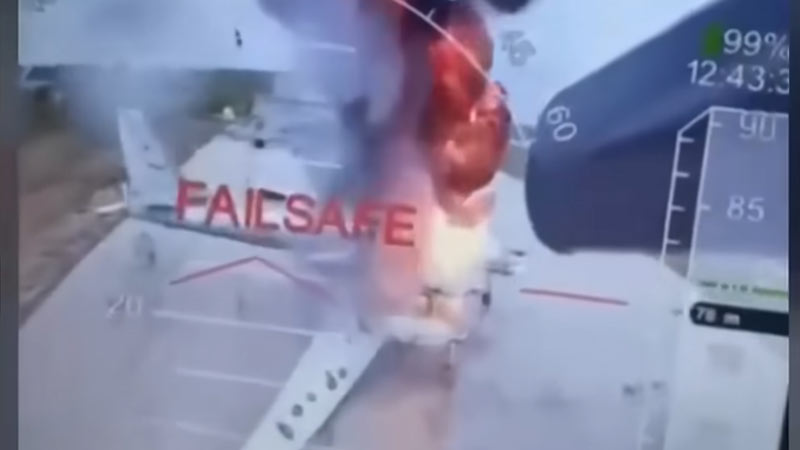Ukraine’s SBU drones destroy over 40 military aircraft inside Russia

An operation by Ukraine’s Security Service (SBU) using first-person-view (FPV) drones smuggled deep inside Russian and hidden inside trucks has hit 41 Russian heavy bombers at four airfields across the country, a source in the agency told the Kyiv Independent on June 1, 2025.
The operation codenamed “Spider web” and a year-and-a-half in the planning appears to have dealt a major blow to the aircraft Moscow uses to launch long-range missile attacks on Ukraine’s cities.
“The SBU first transported FPV drones to Russia, and later, on the territory of the Russian Federation, the drones were hidden under the roofs of mobile wooden cabins, already placed on trucks,” the source said.
“At the right moment, the roofs of the cabins were opened remotely, and the drones flew to hit Russian bombers.”
The source said one of the airfields hit was the Belaya air base in Russia’s Irkutsk Oblast, more than 4,000 kilometers from Ukraine.
Olenya air base in Russia’s Murmansk Oblast, the Diaghilev airbase in Ryazan Oblast, Ivanovo airbase in Ivanovo Oblast were also targeted.
“Currently, more than 40 aircraft are known to have been hit, including the A-50, Tu-95 and Tu-22 M3,” the source added.
The SBU later reported that the drone operation caused approximately $7 billion in damages and disabled 34% of cruise missile carriers in key Russian airbases.
The agency said that more details will be revealed soon. Also, they vowed to continue to drive Russian forces out of Ukrainian territory.
“We will strike them (Russia) at sea, in the air, and on the ground. And if needed, we’ll get them from underground too,” the SBU said.
A video provided by the source shows what appears to be a row of heavy bomber aircraft on fire at one of the airbases.
Unconfirmed videos posted on social media show FPV drones being launched from trucks parked near the airfields.
Irkutsk Oblast Governor Igor Kobzev later confirmed “a drone attack on a military unit in the village of Sredny” and said the “source” of the drones was a “truck.”
Murmansk Governor Andrey Chibis later confirmed that “enemy drones have attacked the territory of the Murmansk region” but gave no further details.
Later on June 1, Russia’s Defense Ministry acknowledged what it described as a “terrorist attack” on the four air bases and said “several units of aircraft caught fire” at Murmansk and Irkutsk.
Ukraine has long-struggled to target the Russian bombers used to launch mass missile targets against Ukrainian cities, as Moscow has kept them out of range of weapons Kyiv has developed itself as well as those supplied by its Western allies.
The use of FPV drones in such a way would mark just the latest stage in the ever-evolving and still relatively fledgling world on drone warfare.
The attack was also likely highly cost effective — FPV drones can be bought for a just a few hundred dollars each but the cost of 41 heavy bombers runs into the billions.
The source said that those behind the operation have “been in Ukraine for a long time.”
“So, if the Putin regime demonstratively detains someone, it will be another staged performance for the domestic audience,” they said.
President Volodymyr Zelensky and SBU Chief Vasyl Malyuk personally oversaw the operation, they added.
In March, Ukraine announced it had developed a new drone with a range of 3,000 kilometers but gave no details about its type, its name, the size of its warhead, or when it would go into mass production.
The Russian aircraft allegedly hit
The A-50 provides several critical functions for the ongoing war in Ukraine, such as detecting air defense systems, guided missiles, and coordinating targets for Russian fighter jets.
Russia possesses fewer than ten of these planes. A-50 aircraft have an estimated price tag of around $350 million.
The Tupolev Tu-95, the Tupolev Tu-22, as well as the Tupolev Tu-160, are all Russian heavy bombers regularly used to launch missiles at Ukrainian cities.
The Tu-95 is the oldest of the three aircraft, a Soviet-era plane that made its first flight in 1952. It was originally used to carry nuclear bombs but has since evolved to launch cruise missiles.
Each aircraft can carry 16 cruise missiles – either the Kh-55/Kh-555 or the newer Kh-101 and Kh-102 air-launched cruise missiles.
It features turboprop engines rather than jet engines, as during the Cold War, their increased efficiency allowed it to fly all the way to the United States without refueling.
The Tu-22 carries the Kh-22 missiles, which pose a particular problem for Ukraine. It is supersonic and travels at around 4,000 kilometers per hour.
Currently, it can only be shot down with the U.S.-made Patriot air defense system and potentially the SAMP-T, a joint Italian-French system.
The Tu-160 is Russia’s more modern strategic bomber, entering service in 1987. To this day, it remains the largest operational bomber in the world.
It can carry a total of 12 Kh-55 missiles and up to 24 Kh-15s.
(Source: The Kyiv Independent – Author: Chris York)
Latest Headlines in Sri Lanka
- Sri Lanka condemns Bondi Beach attack in Australia December 15, 2025
- Sri Lanka estimates USD 400 Million for railway reconstruction after Cyclone Ditwah December 15, 2025
- Large-scale drug trafficker arrested in Wattala with 21 kg of cannabis December 15, 2025
- Tragedy at Bondi Beach: Mass shooting at Jewish festival kills 15, injures dozens December 15, 2025
- India hands over medicines and dry food aid to Sri Lanka December 15, 2025


